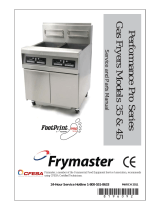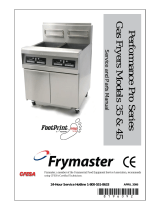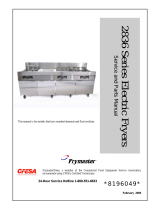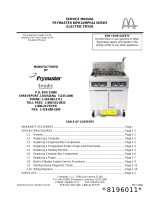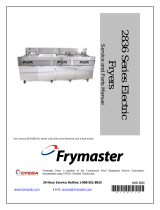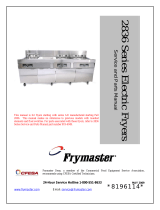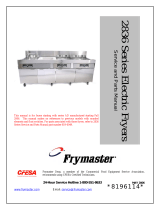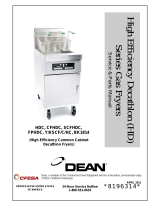Page is loading ...

Frymaster, a member of the Commercial Food Equipment Service Association, recommends
using CFESA Certified Technicians.
819-5795
24-Hour Service Hotline 1-800-551-8633
March 2003
35 Series Gas Fryers
Service & Parts Manual

NOTICE
IF, DURING THE WARRANTY PERIOD, THE CUSTOMER USES A PART FOR THIS ENODIS
EQUIPMENT OTHER THAN AN UNMODIFIED NEW OR RECYCLED PART PURCHASED
DIRECTLY FROM FRYMASTER/DEAN, OR ANY OF ITS AUTHORIZED SERVICE CENTERS,
AND/OR THE PART BEING USED IS MODIFIED FROM ITS ORIGINAL CONFIGURATION, THIS
WARRANTY WILL BE VOID. FURTHER, FRYMASTER/DEAN AND ITS AFFILIATES WILL NOT BE
LIABLE FOR ANY CLAIMS, DAMAGES OR EXPENSES INCURRED BY THE CUSTOMER WHICH
ARISE DIRECTLY OR INDIRECTLY, IN WHOLE OR IN PART, DUE TO THE INSTALLATION OF
ANY MODIFIED PART AND/OR PART RECEIVED FROM AN UNAUTHORIZED SERVICE CENTER.
NOTICE
This appliance is intended for professional use only and is to be operated by qualified
personnel only. A Frymaster/DEAN Factory Authorized Service Center (FASC) or other qualified
professional should perform installation, maintenance, and repairs. Installation, maintenance,
or repairs by unqualified personnel may void the manufacturer’s warranty. See Chapter 1 of
this manual for definitions of qualified personnel.
NOTICE
This equipment must be installed in accordance with the appropriate national and local codes of
the country and/or region in which the appliance is installed. See NATIONAL CODE
REQUIREMENTS in Chapter 2 of this manual for specifics.
NOTICE TO U.S. CUSTOMERS
This equipment is to be installed in compliance with the basic plumbing code of the Building
Officials and Code Administrators International, Inc. (BOCA) and the Food Service Sanitation
Manual of the U.S. Food and Drug Administration.
NOTICE
Drawings and photos used in this manual are intended to illustrate operational, cleaning and
technical procedures and may not conform to onsite management operational procedures.
NOTICE TO OWNERS OF UNITS EQUIPPED WITH COMPUTERS
U.S.
This device complies with Part 15 of the FCC rules. Operation is subject to the following two
conditions: 1) This device may not cause harmful interference, and 2) This device must accept
any interference received, including interference that may cause undesired operation. While
this device is a verified Class A device, it has been shown to meet the Class B limits.
CANADA
This digital apparatus does not exceed the Class A or B limits for radio noise emissions as set
out by the ICES-003 standard of the Canadian Department of Communications.
Cet appareil numerique n’emet pas de bruits radioelectriques depassany les limites de classe A
et B prescrites dans la norme NMB-003 edictee par le Ministre des Communcations du Canada.
DANGER
Improper installation, adjustment, maintenance or service, and unauthorized alterations or
modifications can cause property damage, injury, or death. Read the installation, operating,
and service instructions thoroughly before installing or servicing this equipment. Only qualified
service personnel may convert this appliance to use a gas other than that for which it was
originally configured.

DANGER
No structural material on the fryer should be altered or removed to accommodate placement of
the fryer under a hood. Questions? Call the Frymaster/Dean Service Hotline at 1-800-551-8633.
DANGER
Adequate means must be provided to limit the movement of this appliance without depending
upon the gas line connection. Single fryers equipped with legs must be stabilized by installing
anchor straps. All fryers equipped with casters must be stabilized by installing restraining
chains. If a flexible gas line is used, an additional restraining cable must be connected at all
times when the fryer is in use.
DANGER
The front ledge of the fryer is not a step! Do not stand on the fryer. Serious injury can result
from slips or contact with the hot oil.
DANGER
Do not store or use gasoline or other flammable liquids or vapors in the vicinity of this or any
other appliance.
DANGER
Instructions to be followed in the event the operator smells gas or otherwise detects a gas leak
must be posted in a prominent location. This information can be obtained from the local gas
company or gas supplier.
DANGER
This product contains chemicals known to the state of California to cause cancer and/or birth
defects or other reproductive harm.
Operation, installation, and servicing of this product could expose you to airborne particles of
glasswool or ceramic fibers, crystalline silica, and/or carbon monoxide. Inhalation of airborne
particles of glasswool or ceramic fibers is known to the State of California to cause cancer.
Inhalation of carbon monoxide is known to the State of California to cause birth defects or other
reproductive harm.

35 SERIES GAS FRYERS
TABLE OF CONTENTS
i
CHAPTER 1: Service Procedures
1.1 Functional Description.........................................................................................1-1
1.2 Accessing Fryer for Servicing .............................................................................1-2
1.3 Cleaning the Gas Valve Vent Tube .....................................................................1-2
1.4 Checking Burner Manifold Pressure....................................................................1-2
1.5 Adjusting Burner Ceramic Target Spacing and Alignment.................................1-2
1.6 Adjusting Pilot Flame..........................................................................................1-3
1.7 Calibrating Thermostat Control...........................................................................1-3
1.8 Replacing Fryer Components ..............................................................................1-5
1.8.1 Replacing the Operating Thermostat in Standard MJ35 Fryers...........................1-5
1.8.2 Replacing the Operating Thermostat in G-Model Fryers....................................1-5
1.8.3 Replacing the High-Limit Thermostat in Standard MJ35 Fryers ........................1-6
1.8.4 Replacing the High-Limit Thermostat in G-Model Fryers..................................1-6
1.8.5 Replacing Burner Ceramic Targets...................................................................... 1-7
1.8.6 Replacing the Gas Valve......................................................................................1-8
1.8.7 Replacing Pilot Assembly or Thermopile............................................................1-8
1.8.8 Replacing the Frypot..........................................................................................1-10
1.9 Troubleshooting and Problem Isolation.............................................................1-11
1.9.1 Pilot Failures......................................................................................................1-12
1.9.2 Problems Related to the Gas and/or Electrical Current..................................... 1-12
1.9.3 Problems Related to the Electrical Circuits....................................................... 1-13
1.9.4 Problems Related to the Gas Valve ...................................................................1-13
1.9.5 Improper Burner Functioning............................................................................ 1-14
1.9.6 Improper Temperature Control..........................................................................1-15
1.9.7 Filtration Problems.............................................................................................1-15
1.9.8 Leakage..............................................................................................................1-17
1.9.9 Basket Lift Malfunctions ...................................................................................1-17
Binding/Jamming Problems...............................................................................1-18
Motor Problems .................................................................................................1-18
Electrical Problems............................................................................................1-18
Bell Crank Basket Lift Wiring Diagram............................................................1-18
1.10 Probe Resistance Chart......................................................................................1-19
CHAPTER 2: Parts List
Accessories ......................................................................................................................2-1
Basket Lift........................................................................................................................2-2
Cabinetry..........................................................................................................................2-3
Drain System Components ..............................................................................................2-4
Filter Boxes......................................................................................................................2-6
Filter Pans ........................................................................................................................2-7
Frypots .............................................................................................................................2-8
Gas Valves and Burner Components.............................................................................2-10
Oil Return Plumbing Components................................................................................. 2-12
Power Shower and Oil Return Handle Components......................................................2-14
Thermostats, Timer, and Related Components.............................................................. 2-15

35 SERIES GAS FRYERS
CHAPTER 1: SERVICE PROCEDURES
1-1
1.1 Functional Description
The 35 Series fryers contain a welded steel (stainless or cold-rolled) frypot that is directly heated by
gas flames that are diffused evenly over its lower surface by ceramic deflectors (targets).
The flames originate from orifices in a U-shaped burner manifold positioned beneath the frypot.
The orifice diameters differ for natural and LP gas as indicated in the accompanying table.
Gas Inches Millimeters
Natural (G20/25) 0.0669 1.70mm
LP (G31) 0.0413 1.05mm
35 Series Orifice Sizes (0-1999 ft/609 m)
Gas flow to the manifold is regulated by an electromechanical gas valve. This series of fryers is
equipped with a millivolt gas valve and all models use a pilot ignition system.
Pilot Ignition System
The pilot ignition system is made up of the pilot orifice, pilot hood, and a thermopile. The pilot
serves two purposes: light the burner and heat the thermopile. In operation, the thermopile is in con-
tact with the pilot flame and generates millivolts. The millivolt output passes through a normally
closed high-limit switch and energizes the gas valve pilot coil, which in turn opens the pilot valve.
If the pilot flame is extinguished, voltage is lost to the gas valve pilot coil and the pilot valve closes
Control Options
The temperature control knob on FM/MJ35 fryers is located behind the hinged front panel, out of
sight. On FM/MJ35G fryers, the knob is exposed on the face of the front panel. The MJ35G model
may be equipped with optional basket lifts. The basket lift option requires an electrical power
supply.
Thermostats
Fryers in this series are equipped with an adjustable controlling (operating) thermostat. The
temperature at which the thermostat opens and closes is adjusted by turning the temperature control
knob referenced above. The controlling thermostat used in the 35 Series fryers is sensitive to
one-degree changes in temperature.
All 35 Series fryers are equipped with a high-limit thermostat. In the event that the fryer fails to
properly control the oil temperature, the high-limit thermostat prevents the fryer from overheating to
the flash point. The high-limit thermostat acts as a normally closed power switch that opens when
exposed to temperatures above 425ºF to 450ºF (218ºC to 232ºC). The high-limit thermostat is the
same for CE and Non-CE applications, but the terminals for attaching it to the gas valve differ.
When a replacement high-limit thermostat is ordered, the terminals for both applications are
furnished in the kit.

1-2
1.2 Accessing Fryers for Servicing
DANGER
Moving a fryer filled with cooking oil may cause spilling or splattering of the hot
liquid. Follow the draining instructions in Chapter 4 of this manual before
attempting to relocate a fryer for servicing.
1. Drain shortening from fryer.
2. Shut off the gas supply to the unit. Unplug the power cord(s) if equipped. Disconnect the unit
from the gas supply.
3. Remove any attached restraining devices.
4. Relocate the fryer for service accessibility.
5. After servicing is complete, reconnect the unit to the gas supply, reattach restraining devices, and
plug in the electrical cords.
6. Refill with shortening.
1.3 Cleaning the Gas Valve Vent Tube
Refer to Semi-Annual Checks and Services in Chapter 5, Preventive Maintenance, of the Installation
and Operation Manual (P/N 819-5776).
1.4 Checking the Burner Manifold Gas Pressure
Refer to Semi-Annual Checks and Services in Chapter 5, Preventive Maintenance, of the Installation
and Operation Manual (P/N 819-5776).
1.5 Adjusting Burner Ceramic Target Spacing and Alignment
DANGER
Drain the frypot or remove the handle from the drain valve before proceeding further.
Proper spacing of the top edge of the burner ceramic targets is ¾ inch (13 mm) from the frypot side.
To adjust target spacing, bend the brackets to which they are attached away or toward the frypot to
the proper distance. (A length of board of the proper thickness is useful as a gauge to verify spacing
and alignment.)
3/4-inch
There should be about 3/4-inch spacing between the
top edge of the targets and the side of the frypot.

1-3
1.6 Adjusting the Pilot Flame
Non-CE Gas Valves
1. For Non-CE Gas Valves, remove the screw
from the pilot adjustment screw hole on the gas
valve.
2. Using a small, flat-tipped screwdriver, turn the
pilot adjustment screw counterclockwise to in-
crease the length of the flame or clockwise to
decrease the length of the flame. Adjust flame
to a length of 1 to 1½ inches (25 to 38mm).
3. Reinstall the pilot adjustment screw cap.
CE Gas Valves
Using a small, flat-tipped screwdriver, turn the pilot
adjustment screw counterclockwise to increase the
length of the flame or clockwise to decrease the
length of the flame. Adjust flame to a length of 25
to 38mm.
The pilot adjustment screw on the Non-CE
Honeywell valve is under this screw.
The pilot adjustment on the CE valve is here.
1.7 Calibrating the Thermostat Control
On Standard MJ35 Fryers
1. Fill the frypot to the lower OIL-LEVEL line with cooking oil. If solid shortening is used, it must
be tightly packed into the frypot before starting calibration procedure.
2. Light the pilot. (Refer to Chapter 3 of the Installation and Operation Manual, P/N 819-5776 for
detailed lighting instructions.)
3. Insert a good grade thermometer or pyrometer into the frypot, about one inch from the
thermostat.
4. Set the thermostat to 325°F (162°C).
5. Let the burner cycle on and off three times.

1-4
6. Take a pyrometer reading when the burners go off for the third time.
7. Loosen the setscrews in the thermostat knob and turn knob to the temperature established by the
pyrometer reading.
8. Allow burners to cycle on and off three more times and recheck pyrometer reading against
thermostat setting. Temperature readings should be within 5°F (2°C).
On G-Model Fryers
1. Fill the frypot to the lower OIL-LEVEL line with cooking oil. If solid shortening is used, it must
be tightly packed into the frypot.
2. Light the pilot. (Refer to Chapter 3 of the Installation and Operation Manual, P/N 819-5776, for
detailed lighting instructions.)
3. Insert a good grade thermometer or pyrometer into the frypot, about one inch from the
thermostat.
4. Set the thermostat to 325°F (162°C).
5. Allow the burners to cycle on and off three times. Compare the reading of the pyrometer to the
setting on the thermostat plate. The position of the knob on the thermostat and the reading from
the pyrometer should be within 5°F (2°C) of each other.
6. If not, loosen the setscrew and stop screw securing the thermostat shaft extension to the flexible
shaft. Remove the extension to expose the slot in the end of the flexible shaft. Use a flatblade
screwdriver to adjust the thermostat.
7. When the cooking oil temperature reaches 325ºF (162ºC), turn the flexible shaft slowly clock-
wise until the burner shuts off. (Turning the shaft counterclockwise causes the burner to light;
turning it clockwise causes it to shut off.)
8. Allow the fryer to sit for a few minutes, then slowly turn the flexible shaft counterclockwise
until the burner lights.
9. Repeat steps 6 and 7 at least three times to ensure an accurate setting is obtained. The thermostat
control is considered to be properly calibrated if the burner lights as the cooking oil cools to
325ºF (162ºC)—not when the burner shuts off as the temperature rises.
10. Once the calibration point of 325ºF (162ºC) is determined, allow the burner to cycle on and off at
least three times to be sure it will light at the calibrated temperature.
11. Carefully replace the thermostat shaft extension, ensuring that the stop screw is pointed straight
up. Tighten the stop screw and locking nut and the setscrew, being careful not to rotate the
flexible shaft.
CAUTION
The thermostat flexible shaft must not be rotated while installing the thermostat
shaft extension.

1-5
12. Close the fryer control panel and replace the screws in the upper corners.
13. Reinstall the thermostat knob with its pointer aligned with the 325ºF (162ºC) index mark on the
temperature dial.
14. Reconnect the fryer to the electrical power supply.
1.8 Replacing Fryer Components
1.8.1 Replacing the Operating Thermostat in Standard MJ35 Fryers
1. Drain the fryer and turn the gas off.
2. Use an allen wrench to loosen setscrew at the side of the thermostat knob. Remove the
thermostat knob.
3. Remove the two setscrews on either side of the
thermostat shaft and remove the dial plate.
4. Disconnect the thermostat wires from gas valve.
5. Use a slotted socket to unscrew the thermostat
from the frypot.
6. Apply a small amount of Loctite™ PST56765
compound to the threads of the new thermostat
and screw it into the frypot, torquing to 180
inch-pounds.
Setscrews hold the knob and dial plate to the
thermostat. Use an allen wrench to remove both.
7. Recalibrate the thermostat (see Section 1.7).
CAUTION
The operating thermostat must be calibrated after installation is complete. Refer to
Section 1.7 for calibration instructions.
1.8.2 Replacing the Operating Thermostat in G-Model Fryers
1. Drain the fryer and turn the gas off.
2. Use an allen wrench to loosen the setscrews on
the side of the thermostat knob. Remove the
knob and the control panel.
3. Loosen the setscrew attaching the flexible shaft
to the thermostat shaft.
4. Remove the two setscrews that hold the flexible
shaft bracket in place. Remove the bracket and
the shaft.
On G-Model fryers, the shaft connecting the exterior
thermostat knob to the frypot-mounted thermostat
must be disconnected.

1-6
5. Use a slotted socket to unscrew the thermostat from the frypot.
6. Apply a small amount of Loctite™ PST56765 compound to the threads of the new thermostat
and screw it into the frypot, torquing to 150 foot-pounds.
7. Recalibrate the thermostat (see Section 1.7).
CAUTION
The operating thermostat must be calibrated after installation is complete. Refer to
Section 1.7 for calibration instructions.
1.8.3 Replacing the High-Limit Thermostat in Standard MJ35 Fryers
1. Drain the fryer and turn the gas off.
2. Disconnect the wires at the gas valve.
3. Use a slotted socket to unscrew the high-limit
thermostat from the frypot.
4. Apply a small amount of Loctite™ PST56765
compound to the threads of the new thermostat.
The high-limit thermostat on the standard MJ35 is
located below the thermostat dial.
5. Screw the replacement thermostat into the frypot, torquing to 180 inch-pounds.
1.8.4 Replacing the High-Limit Thermostat in G Series Fryers
1. Drain the fryer and turn the gas off.
2. Disconnect basket lift- or filter-equipped fryers
from the electrical power supply.
3. Disconnect the thermostat wires from the gas
valve.
4. Use a slotted socket to unscrew the thermostat
from the frypot.
On G-Model fryers, the high-limit thermostat is
accessed through the cabinet dooor.
5. Apply a small amount of Loctite™ PST56765 compound to the threads of the new thermostat.
6. Screw the replacement thermostat into the frypot, torquing to 180 inch-pounds.

1-7
1.8.5 Replacing Burner Ceramic Targets
DANGER
Drain the frypot or remove the handle from the drain valve before proceeding further.
1. Disconnect the fryer from the electrical power
and gas supplies.
2. On FM35 fryers, remove sections of the
square-drain as necessary to expose the burner.
3. Disconnect the wires from the gas valve
terminal block and pilot coil, marking each
wire to facilitate reconnection.
4. Disconnect the pipe union collar at the right
side of the gas valve.
5. Remove the burner hanger screws and lower
the front of the main burner. Pull it forward to
clear the rear burner hanger, then lower the
burner to the floor.
6. Raise the front of the fryer enough to slide the
burner from under the fryer cabinet.
7. To replace a ceramic target only, remove the
wire, straighten the target locking tab with a
pair of needle nose pliers or a screwdriver, and
slide the target up and off the bracket. Slide the
replacement target onto the bracket and bend the
locking tabs down.
Step 2: On FM35 fryers, sections of the drain system
must be removed to access the burner assembly.
Step 3: Mark and disconnect the wires from the gas
valve.
Step 5: These screws on each side of the drain valve
must be removed to lower the burner from the frypot.
To replace a ceramic target only, remove
the wire, bend this tab outward, and slide
the target up and off the bracket.
To replace the entire target assembly,
use a 1/2-inch box end wrench to
remove the orifice that holds the target
to the manifold assembly.

1-8
8. To replace the entire target assembly, use a ½-inch box end wrench to remove the brass orifice
that holds the assembly to the burner manifold. Position the new assembly and reinstall the
orifices.
WARNING
Use extreme care to prevent cross-threading and stripping when reinstalling the
brass orifices.
9. Reverse steps 1-8 to reinstall the burner assembly. Check spacing and alignment of targets in
accordance with Section 1.5.
1.8.6 Replacing the Gas Valve
DANGER
Drain the frypot or remove the handle from the drain valve before proceeding further.
1. Disconnect fryer from electrical and gas supplies
2. Disconnect the wires from the gas valve, marking each wire to facilitate reconnection.
3. Disconnect the pilot gas line fitting from the gas valve.
4. Disconnect the pipe union collars to the left and right of the gas valve and remove the valve.
5. Remove the pipefittings from the old gas valve and install on the replacement valve, using
Loctite™ PST56765 or equivalent pipe thread sealant on threads.
6. Reverse steps 1-4 to install the replacement gas valve.
1.8.7 Replacing the Pilot Assembly or Thermopile
DANGER
Drain the frypot or remove the handle from the drain valve before proceeding further.
1. Remove the burner assembly in accordance with steps 1-8 of Section 1.8.5.
2. To replace only the thermopile in fryers with the earlier design pilot assembly (see illustration at
top of Page 1-9):
a. Disconnect the thermopile lead(s) from the gas valve pilot coil.
b. Remove the screws that secure the pilot assembly guard.
c. Bend the tab away from the base of the thermopile.
d. Press down on the top of the thermopile to force it out of the pilot assembly.
e. Reverse steps a through c to install the replacement thermopile.

1-9
a: Remove these screws
to release guard.
b: Bend this clip outward to
release thermopile.
c: Press down on top of thermopile,
forcing it out of the pilot bracket.
3. To replace only the thermopile in fryers with the current design pilot assembly (see illustration
below), use a
7
⁄
16
-inch open-end wrench to loosen the thermopile, then unscrew it from the pilot
assembly. Screw the replacement into the pilot assembly and use a wrench to tighten it ¼-turn
past finger tight.
Ferrule on thermopile
unscrews from bottom of pilot.
3. To replace the complete pilot assembly of either design:
a. Disconnect the pilot tubing from the bottom of the pilot assembly.
b. Disconnect the thermopile lead(s) from the gas valve pilot coil.
c. Remove the screw(s) from the pilot-mounting bracket to release the pilot assembly.
d. Reverse steps a through c to install the replacement pilot assembly.
4. Reinstall the burner assembly by reversing steps 1-8 of Section 1.8.5.

1-10
1.8.8 Replacing the Frypot
1. Drain the frypot.
2. Remove all accessories (e.g., frypot covers, basket lift arms, etc.) from the fryer.
3. Disconnect the fryer from the gas and electrical power supplies.
4. Remove the screws from the top cap above the
control panel and lift it up and off the fryer(s).
5. If fryer is a G-Model, remove the thermostat
knob.
6. Remove the control panel.
7. Loosen the setscrew on the flexible shaft and
separate it from the thermostat shaft.
8. Remove the two screws holding the flexible
shaft bracket and remove the flexible shaft and
bracket.
9. Remove the control panel frame.
10. Remove the screw from the frypot hold-down
bracket.
Four screws, these two and two on each end, secure the
topcap to the fryer.
The flexible shaft on G-Model fryers must be
disconnected from the thermostat and the shaft and
bracket must be removed.
When the topcap is removed, this screw is
exposed. It must be removed to free the frypot.
11. For fryers with a filter system, remove the square drain tubing from the drain valve.

1-11
12. Remove the screws from the sides and back of
the fluecap and remove the fluecap.
Three screws, on each side of the fluecap, must be
removed.
13. Disconnect the oil return lines or hoses on fryers equipped with filter systems.
14. Lift the frypot, complete with the burner, gas valve, flue, and drain valve, from the fryer cabinet.
After lifting the frypot partially out of the cabinet, tilt the front downward to allow the drain
valve to clear the cabinet top and front crossbar.
15. Remove the drain valve, hi-limit thermostat, and operating thermostat from the frypot and
transfer them to the replacement frypot. Before installing the thermostats and drain valve on the
replacement frypot, clean threads and apply Loctite™ PST56765 thread sealant or equivalent to
the threads.
16. Reverse the steps of the procedure to install the new frypot.
CAUTION
Before installing the operating thermostat, high-limit thermostat, and drain valve on
the replacement frypot, clean their threads and apply Loctite™ PST56765 thread
sealant or equivalent to the threads.
1.9 Troubleshooting and Problem Isolation
This section is intended to provide technicians with a general knowledge of the broad problem
categories associated with this equipment, and the probable causes of each. With this knowledge, the
technician should be able to isolate and correct any problem encountered.
Problems you are likely to encounter can be grouped into these broad categories:
1. Pilot failures
2. Improper burner functioning
3. Improper temperature control
4. Filtration problems
5. Leakage problems

1-12
6. Basket Lift malfunctions.
The probable causes of each category are discussed in the following sections. A series of
Troubleshooting Guides is included at the end of the chapter to assist in identifying some of the
more common problems.
1.9.1 Pilot Failures
There are two categories: no pilot flame and unreliable flame.
No pilot flame
1. No gas or insufficient gas supply
2. Clogged pilot orifice
3. Air in gas lines ( usually in new installations)
Unreliable flame
1. Open or grounded high limit
2. Loose/corroded wire connections
3. Low or no voltage out of thermopile
4. Bad gas valve
1.9.2 Problems Related to the Gas and/or Electrical Current
CONTROL CIRCUIT FOR THE 35 SERIES MILLIVOLT IGNITION SYSTEM
2C
1C
8050438B
THERMOSTAT
OPERATING
FENWALL
ROBERTSHAW
HONEYWELL 1/2 P.S.I.
1/2 P.S.I.
HONEYWELL
OFF
ON
PILOT
C
HONEYWELL
1/2 P.S.I.
ADJ.
PILOT
OFF
4
0
0
3
5
0
3
0
0
2
5
0
2
0
0
OPERATING
THERMOSTAT
HI-LIMIT
THERMOSTAT
PILOT
GENERATOR
INSET 1
SAFETY DRAIN
SWITCH
INSET 2
ON/OFF
SWITCH
(OPTIONAL)
17C
17C
12C
IN LINE SPLICE
IN LINE SPLICE

1-13
The main indicator of a gas or electrical circuit problem is that an entire battery of fryers fails to
light. Verify that the quick disconnect fitting on the flexible gas hose is properly connected, the
fryer is plugged in, and the main gas supply valve is open.
1.9.3 Problems Related to the Electrical Circuits
If gas is being supplied to the fryer, the next most
likely cause of ignition failure is a problem in the
millivolt circuit of the pilot system. If the fryer is
equipped with a Filter Magic II filtration system,
first verify that the drain valve is fully closed. (The
valve handle interacts with a microswitch that must
be closed for power to reach the gas valve. Often,
although the valve handle appears to be in the
closed position, the microswitch is still open.) If
the valve is fully closed, or the fryer does not have a
filtration system, refer to the troubleshooting
guides.
The flat on the drain valve
handle must firmly engage the
flexible arm on the microswitch
to allow the burner to fire.
The drain valve handle interacts with a microswitch that
prevents the burner from firing if the drain valve is open.
1.9.4 Problems Related to the Gas Valve
If the problem is not in the millivolt circuit of the pilot system, it is most likely in the gas valve it-
self. Follow these steps to check a Honeywell valve:
1. Complete System Check: With the thermostat
contacts closed and gas cock dial “ON,” main
burner should ignite. If not measure across ter-
minals 2 and 3 as indicated by the diagram. If
the reading is more than 180MV, replace the gas
valve.
2. System Resistance Check: With the thermostat
contacts closed and main burner “ON”, measure
the millivolts between terminals 1 and 3 as
indicated by the diagram. Reading should not be
greater than 220MV, If greater, re-check
thermostat leads and connections. Replace with
new or heavier gauge wires if necessary. If the
reading is still greater than 220MV, replace the
thermostat.
4
2
3
1
Test
Meter
Setting
Meter Leads
on Terminals
Acceptable
Results
1 MV 2 3 Less than 180MV
2 MV 1 3 Less than 220MV
3 MV 1 2 110-36 MV
3. Automatic Pilot Dropout Check: With the thermostat contacts open, depress gas cock knob
with pilot lit until maximum millivolt output is observed between terminals 1 and 2. Extinguish
the pilot and observe the meter. The sound of the pilot magnet dropping should be audible. The
dropout should occur between 110 MV and 36MV. If the dropout occurs outside those limits,
replace the gas valve.

1-14
Follow these steps to troubleshoot a Robertshaw Valve:
1. Complete System check: With the thermostat
contacts closed and gas cock dial “ON”, main
burner should ignite. If not, measure across TP
and TH terminals. If the reading is more than
100 MV, replace the gas valve.
2. System Resistance Check: With the thermostat
contacts closed and main burner “ON”, measure
the millivolt reading between THTP and TH
terminals. Reading should be less than 80MV. If
not, recheck thermostat leads and connections.
Replace with new or heavier gauge wires if
necessary. If the reading is still greater than 80
MV, replace the thermostat.
Millivolt Operator Terminal
Panel
Terminal 1
Terminal 2
Terminal 3
TH
TP
TH
TP
Test
Meter
Setting
Meter Leads
on Terminals
Acceptable
Results
1 MV TP TH Less than 100MV
2 MV THTP TH Less than 80MV
3 MV THTP TP 120-30MV
3. Automatic Pilot Dropout Check: With the thermostat contacts open, depress gas cock knob
with pilot lit until maximum millivolt output is observed between terminals THTP and TP.
Extinguish the pilot and observe the meter. The sound of the pilot magnet dropping should be
audible. The dropout should occur between 120MV and 30MV. If outside these limits, change
the gas valve.
1.9.5 Improper Burner Functioning
The burner lighting on one side only may be caused by a missing or misaligned rear deflector target
or improper burner manifold pressure. Clogged burner orifices are usually the cause of gaps in
burner firing.
Fluctuating flame intensity is normally caused by either improper or fluctuating incoming gas
pressure, but may also be the result of variations in the kitchen atmosphere. Verify incoming gas
pressure in the same way as for “popping,” discussed in the preceding paragraphs. Variations in the
kitchen atmosphere are usually caused by air conditioning and/or ventilation units starting and
stopping during the day. As they start and stop, the pressure in the kitchen may change from
positive or neutral to negative, or vice versa. They may also cause changes in airflow patterns that
may affect flame intensity.
Flames “rolling” out of the fryer are usually an indication of negative pressure in the kitchen. Air
is being sucked out of the fryer enclosure and the flames are literally following the air. If negative
pressure is not the cause, check for high burner manifold gas pressure in accordance with the
procedures in Chapter 5 of the Installation and Operation Manual (P/N 819-5776). An obstructed
flue, which prevents the fryer from properly exhausting, may also be the cause.
An excessively noisy burner, especially with flames visible above the flue opening, may indicate
that the burner gas pressure is too high, or it may simply be that the gas valve vent tube is blocked.
If the gas pressure is correct and the vent tube in unobstructed, the gas valve regulator is probably
defective.

1-15
Occasionally a burner may apparently be operating correctly, but nevertheless the fryer has a slow
recovery rate (the length of time required for the fryer to increase the oil temperature from 250ºF to
300ºF (121ºC to 149ºC). The primary causes of this are low burner manifold pressure and/or
misaligned or missing deflector targets. If both of these causes are ruled out, the probable cause is a
gas valve regulator that is out of adjustment. Refer to the Check Burner Manifold Pressure
procedure in the semi-annual checks and services section of Chapter 5 of the Installation and
Operation Manual (P/N 819-5776).
1.9.6 Improper Temperature Control
Temperature control is a function of several interrelated components, each of which must operate
correctly. The principle component is the operating thermostat. Other components that may affect
temperature control are the high-limit thermostat and the gas valve. The high-limit thermostat is
checked by comparing the resistance in its leads for a given temperature with the chart on Page 1-19.
See Section 1.9.4 for the procedures for checking the gas valve.
Failure to Control at Setpoint
The problem will be with the thermostat itself. Possible causes are that the thermostat is out of
calibration, the knob or flexible shaft is loose on the thermostat shaft, a thermostat wire is
disconnected or broken, or the thermostat is defective. Refer to Section 1.7 for instructions on
calibrating the thermostat. To check for thermostat failure: Determine the temperature of the oil in
the frypot using a thermometer or pyrometer placed at the tip of the probe, then check the for a
resistance through the leads that is approximately equal to that given in the Probe Resistance Chart
on Page 1-19 for the corresponding temperature. If this checks OK, check for at least 5 megaohms
of resistance through each of the leads to ground. If both checks are not OK, replace the thermostat.
1.9.7 Filtration Problems
The majority of filtration problems arise from operator error. A common error is placing the filter
paper on the bottom of the filter pan rather than over the filter screen.
When the complaint is “the pump is running, but no oil is being filtered,” check the installation of
the filter paper, including size. While you are checking the filter paper, verify that the O-rings on
the bottom of the filter pan and on the male disconnect (at inside rear of filter cabinet) are present
and in good condition. Missing or worn O-rings will allow the pump to suck air and decrease its ef-
ficiency.
If the pump motor overheats, its thermal overload will trip and the motor will not start until it is
reset. If the pump motor does not start, press the red reset switch located on the end of the motor
nearest the operator. If the pump then starts, something caused the motor to overheat. It may be just
that several frypots were being filtered one after the other and the pump got hot. Letting the pump
cool down for at least a half-hour is all that is required in this case. More often, the pump
overheated for one of the following reasons:
• Shortening was solidified in the pan or filter lines.
• The operator attempted to filter oil or shortening that was not heated. Cold oil and shortening
are thicker and can cause the pump motor to overheat.

1-16
If the motor tries to run but the pump does not, there is a blockage in the pump. Incorrectly sized or
installed paper will allow food particles and sediment to pass through the filter pan and into the
pump. When sediment enters the pump, the gears can bind up causing the motor to overload, again.
A pump seized by debris or hard shortening can
usually be freed by manually moving the gears with
a screwdriver or other instrument.
1. Disconnect power to the filter system.
2. Remove the input plumbing from the pump.
3. Use a screwdriver to manually turn the gears.
• Turning the pump gears backwards will
release a hard particle and allow it to be
removed.
• Turning the pump gears forward will push
softer objects and solid shortening through
the pump and allow free movement of the
gears.
Sediment
Particle
Oil Flow
Up for reverse
Down for
forward
Sediment
Particle
Incorrectly sized or installed paper will also allow food particles and sediment to pass through and
clog the suction tube on the bottom of the filter carriage. Particles large enough to block the suction
tube may indicate that the crumb tray is not being used.
Pan blockage can also occur if shortening is left in
the pan and allowed to solidify. The heater strip on
the suction tube is designed to prevent solidification
of residual shortening left in the tube. It will not
melt or prevent solidification of shortening in the
pan. Blockage removal can be accomplished by
forcing the item out with an auger or drain snake.
Compressed air or other pressurized gases should
not be used to force out the blockage.
Possible problems with the Power Shower include
clogged openings, shortening solidified in the tubes,
missing clean-out plugs, and missing or worn O-
rings. Cleaning the unit and replacing missing
plugs and missing or worn O-rings will correct
these problems.
The electronics of the Filter Magic II are simple and
straightforward. Microswitches, attached to the
drain valve handles of each vat and wired in paral-
lel, provide the 24 VAC needed to activate the
pump relay coil when the handles are moved to the
ON position. The activated coil pulls in the pump
motor switch, supplying power to the motor.
M
Micro-switches
Pump Relay Coil
Pump Motor
24 VAC
Pump Motor Switch
Filter Magic Simplified Wiring Diagram
Pump/return line heater tapes
/

